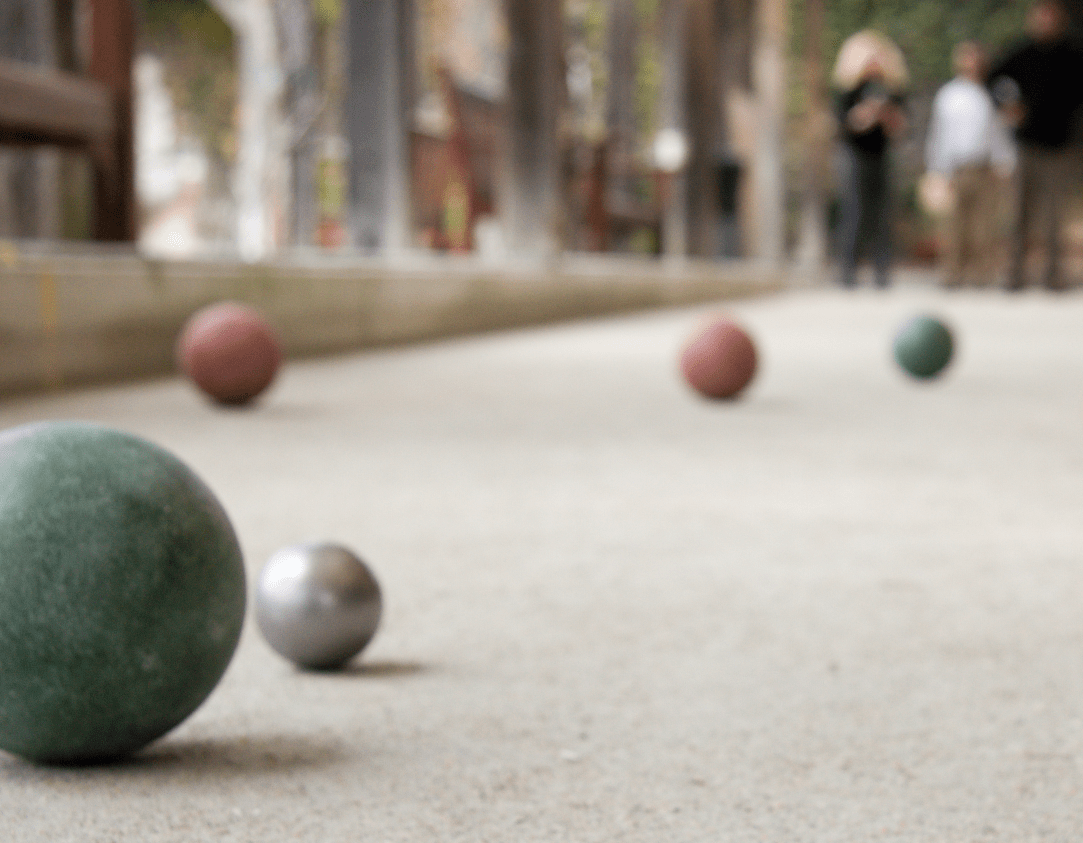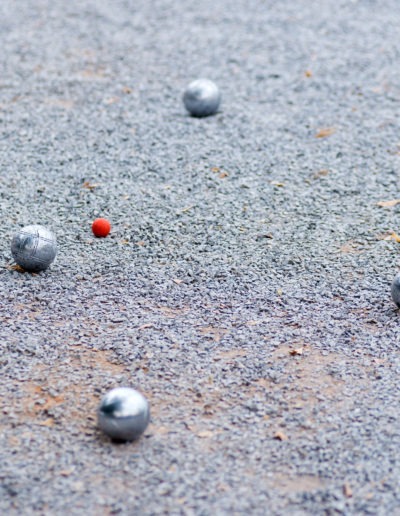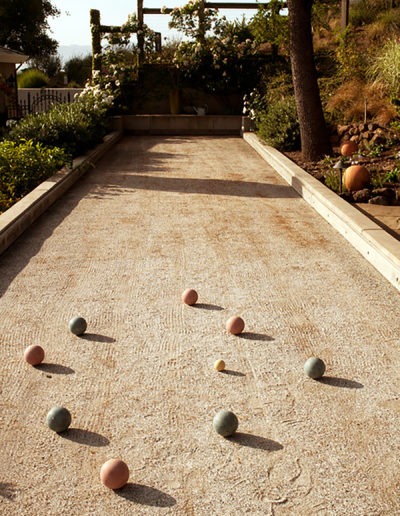Bocce Ball & Pétanque Courts
Why oyster shell is the best choice for your Bocce Courts
Crushed Oyster Shells are the highest quality top coat that can be used for bocce courts. Shells have been used for decades for one very important reason – recalcification.
Unlike clay, sand or other bocce blends, oyster shells are made of 98% calcium carbonate. This means that over time, the shell will re-calcify (fuse) together. When this all-natural process occurs, the result will be a hard, compact surface that is extremely porous. Once the shells re-calcify, you’ll essentially have a rectangular coral reef!
So what’s the secret to our bocce-grade oyster shell?
There is no secret. It’s simply 100% oyster shell, nothing more, nothing less. Made by Mother Nature herself, our oyster shells are crushed to size after being cleaned with a series of high-pressure washers which use distilled water (no cleaning chemicals are ever used).

Many companies offer ‘proprietary’ or ‘secret blends’ of bocce surfaces. Most of these mixes are usually nothing more than powdered clay blended with either oyster shell or a synthetic polymer. Ask yourself which seems more environmentally stable, crushed oyster shell or ‘proprietary’ blends. Our oyster shells are so safe that we offer A Material Safety Data Sheet (MSDS) upon request.
An MSDS sheet is a safety document required by the Occupational Safety and Health Administration (OSHA) that contains data about the physical properties of a material.
If your bocce supplier cannot offer an MSDS sheet due to their ‘secret blends’ be cautious!


About our Shells
We offer three suitable grades of crushed oyster shells for use in bocce courts.
Oyster Shell Flour
The first, and most commonly used is oyster shell flour. This grade is our finest in size and has a bright white color. Its attraction to bocce enthusiasts is its ability to easily be levelled quickly. While at the same time, offering a very porous surface.
Wet/Landscape Grade
Our second grade is a wet/landscape grade. This shell is technically 3/8″ minus. This means that the largest piece of shell you will receive is 3/8″ and smaller. This grade is what most would call a ‘bocce mix’ or ‘bocce blend’. The mix or blend consists of both oyster shell flour and larger pieces of oyster shell. This grade will give your bocce court a rougher texture than the oyster shell flour.
Dried 3/8 Minus
The final grade is our dried shell. This is the same size as our wet/landscape grade except we’ve run the shell through a commercial kiln which dries the material.
For bocce, we recommend either an oyster shell flour or our 3/8″ Blend. Which is better is simply a matter of opinion. Due to differences in taste, we highly recommend obtaining a Sample Pack of our shells. By seeing and feeling the samples, you will be able to make an educated decision about which grade/size will work best for your court. We can also help you determine how many tons you will need. Most bocce ball courts will use between 4 to 9 tons depending on the court’s size. Give Consolidated Shell a call at 412-764-2565 to help in your court construction.
Bocce F.A.Q.s
Is oyster shell environmentally safe?
Oyster Shell is created naturally by, you guessed it, oysters! So, is it environmentally safe? Absolutely! Calcium carbonate, or CaCO3, comprises more than 4% of the earth’s crust and is found throughout the world. The oyster shells themselves are 98% calcium carbonate. If you’re not familiar with calcium carbonate, it’s the main ingredient in chalk and commercially produced antacids such as TUMS.
Is it maintenance-free?
Well, no, no court is maintenance-free.
Ever notice that many companies claim to offer ‘maintenance free’ material but then sell accessories to maintain their courts? Even the fanciest of proprietary blends will always require care.
That being said, the nature of oyster shell is to harden, which will significantly lower the effort required. We suggest keeping your bocce court like a sand trap on a golf course. Clean it before and after you play and have fun in between!
Does oyster shell play fast or slow?
Oyster shell flour as a topcoat is the most commonly used material if you want regular to fast play. Others will use a 3/8″ minus shell for regular to slow play. There is no ‘one size fits all’ material. The nice aspect of using oyster shells is that you can modify your playing surface AFTER your court is built.
Imagine that you build your court and use a 3/8″ minus shell. You play for a few weeks and would prefer to have a faster roll. The solution is simple! Add a little oyster shell flour. It’s all oyster shells, just different sizes. With other materials, the option to change your playing surface requires much more work than just sprinkling some flour on the court.
In our 20+ years of selling shells, roughly 80% of our customers use oyster shell flour. The other 20% use a wet 3/8″ minus size. Please remember that shell sizes and playing speeds are ALL just a matter of personal preference. Many of the bocce clubs we work with, clubs that have multiple courts, will use different size shells for different courts.
Each court having a different playing surface gives their club members variety!
Is oyster shell dust free?
No, there is dust, at first. Any natural material that offers good drainage will have a small amount of dust. That being said, watering your court—a common practice for proper maintenance—is more than enough to reduce this problem. Plus, oyster shells love water! Unlike many other products on the market, oyster shells will re-calcify over time, virtually eliminating the problem of dust. Water is necessary for the re-calcification process to work. The shell will fuse into itself and re-calcify making a hard, porous surface. Have you ever seen or touched a coral reef? They’re essentially recalcified shells, also known as ‘shell beds’.
What does bocce grade oyster shell cost?
The important aspect to consider is the material you’re comparing the shell to. For example, decomposed granite is by far the most compared material and is second next to oyster shell in bocce court topcoats.
When people ask us about using different materials, in most cases it’s like comparing apples with oranges. Oyster shell is mostly calcium carbonate which is used in thousands of different products. Its chemical content is what gives oyster shell its value. Comparing oyster shells with granite or even ‘blended mixes’ would be like comparing sand to paint (which by the way, an ingredient in commercially sold household paint is, calcium carbonate).
How do you ship the shell? And in what quantities?
We’ve been delivering shells nationwide for twenty years. We ship oyster shell flour and dried 3/8″ minus shell in 50-pound buckets, one-ton sacks, full truckloads, rail and barge. For bocce, most will use the one-ton sacks but the dried 50-pound buckets are also an option. We ship to residences or commercial locations.
Do you offer samples?
Yes, yes and yes!
We highly recommend our customers visually inspect the material before placing a bulk order. We process shells in 9 different sizes, each with their own pricing. Out of the 9 sizes, three are most commonly used for bocce (flour, wet & dried 3/8″ minus). You can order one of our sample packs here.
If you happen to reach out to a company and they cannot offer samples, be wary. Shell is not all processed in the same way. We always have shells in stock. Once we receive an order, we use a series of high-pressure washers to clean the shell of any debris (old meat, plant and sand). After the shell has been cleaned, it is then crushed to the desired size. Then, depending on the grade of the shell, it is kept wet or dried. Lastly, the shell is bagged and shipped. That’s all folks.
No mixing of inert materials, no blending of synthetic products. Nothing but cleanly crushed organic oyster shells.
Have more questions?
Please contact our distributor Consolidated Shell at 412-764-2565 for more information or to order a sample pack which includes a variety of different grades of
Consolidated Shell Family Sites: Consolidated Shells Bulk Crushed Oyster Shells Bulk Crushed Clam Shells Myco Supply Bocce Shells
